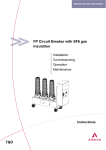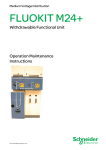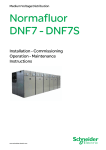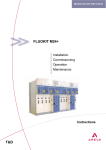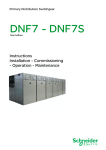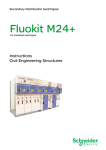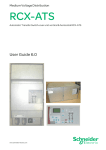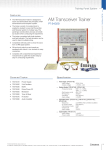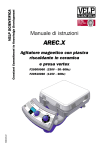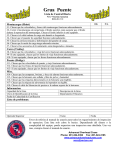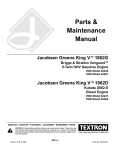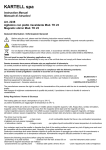Download Circuit Breaker with SF6 gas insulation
Transcript
Medium Voltage Distribution FP Circuit Breaker with SF6 gas insulation Installation Commissioning Operation Maintenance Instructions www.schneider-electric.com FP Contents ■■ Introduction��������������������������������������������������������������������������������������������������������� 4 □□ Our Service Unit: our specialists, and suitably adapted services...��������������� 4 ■■ Overview�������������������������������������������������������������������������������������������������������������� 5 □□ Eco-design concept and valorisation of the materials used ������������������������� 5 □□ Responsibilities���������������������������������������������������������������������������������������������� 5 □□ Reminder concerning normal service conditions (in accordance with IEC 60694)���������������������������������������������������������������������������������������������������������������� 5 • Permissible ambient temperature����������������������������������������������������������������� 5 • Installation altitude���������������������������������������������������������������������������������������� 5 • Atmospheric pollution������������������������������������������������������������������������������������ 5 • Permissible atmospheric humidity level�������������������������������������������������������� 5 □□ Particular instructions for operation and intervention with energized equipment������������������������������������������������������������������������������������������������������������������� 6 □□ Other technical notices to be consulted��������������������������������������������������������� 6 □□ Tools and products (not supplied) required for the operations described in this notice����������������������������������������������������������������������������������������������������������� 6 □□ Symbols & conventions���������������������������������������������������������������������������������� 6 □□ Tightening torque values for standard assemblies (nut + bolt)���������������������� 7 ■■ Presentation of the FP circuit breaker������������������������������������������������������������� 8 □□ Weights and shipping methods for the circuit breakers��������������������������������� 8 ■■ Packaging - Handling - Storage������������������������������������������������������������������������ 9 □□ Transport - Delivery���������������������������������������������������������������������������������������� 9 □□ Packaging for the circuit breakers����������������������������������������������������������������� 9 □□ Packaging for the “Circuit Breaker” moving part�������������������������������������������� 9 □□ Handling the circuit breaker when packed��������������������������������������������������� 10 □□ Storage conditions��������������������������������������������������������������������������������������� 11 □□ Intervention levels���������������������������������������������������������������������������������������� 11 □□ Specific recommendations for storage durations of less than 6 months����� 11 □□ Specific recommendations for storage durations of between 6 and 12 months������������������������������������������������������������������������������������������������������������� 12 □□ Specific recommendations for storage durations of between 12 and 24 months������������������������������������������������������������������������������������������������������������� 12 ■■ Unpacking the circuit breaker������������������������������������������������������������������������� 13 □□ Unpacking the circuit breaker���������������������������������������������������������������������� 13 □□ Identification of the circuit breaker��������������������������������������������������������������� 13 □□ Identification of the circuit breaker with reduced pressure�������������������������� 14 □□ Handling the circuit breaker when unpacked����������������������������������������������� 14 ■■ Installation outside the Functional Unit��������������������������������������������������������� 15 □□ Dimensions of the circuit breakers��������������������������������������������������������������� 15 □□ Dimensions for circuit breakers on the ground�������������������������������������������� 16 ■■ Adjustment of the SF6 gas pressure�������������������������������������������������������������� 18 □□ General instructions for handling and storing gas bottles under pressure�� 18 □□ SF6 filling and pressure checking kit (supplied as an option)��������������������� 18 □□ Preparation of the pressure adjustment tools���������������������������������������������� 18 □□ General instructions for pressure adjustment���������������������������������������������� 19 □□ Pressure adjustment procedure������������������������������������������������������������������� 19 □□ Reminder of the SF6 gas volumes and pressures depending on the circuit breakers����������������������������������������������������������������������������������������������������������� 20 □□ Pressure – Temperature Diagram���������������������������������������������������������������� 21 ■■ Commissioning - Operation���������������������������������������������������������������������������� 22 □□ Precautions to be taken before commissioning������������������������������������������� 22 □□ Electrical connection of the BLR control mechanism���������������������������������� 22 □□ Testing the operation of the circuit breaker�������������������������������������������������� 22 □□ Operation of the circuit breaker������������������������������������������������������������������� 22 2 AMTNoT055-02 02 FP Contents (contd.) ■■ Maintenance – Spare Parts������������������������������������������������������������������������������ 23 □□ Levels of maintenance��������������������������������������������������������������������������������� 23 □□ General Instructions������������������������������������������������������������������������������������� 23 □□ Maintenance of the BLR – BLRM control mechanism��������������������������������� 23 □□ Standard maintenance of the “circuit breaker” part������������������������������������� 23 □□ Systematic preventive maintenance������������������������������������������������������������ 24 □□ Maintenance following an intensive operating rhythm��������������������������������� 24 □□ Pole linkage lubrication points��������������������������������������������������������������������� 24 □□ Recommendations for the poles of the circuit breaker�������������������������������� 24 □□ Corrective maintenance������������������������������������������������������������������������������� 24 □□ Spare parts��������������������������������������������������������������������������������������������������� 24 ■■ Replacement of a pole������������������������������������������������������������������������������������� 25 □□ General Instructions������������������������������������������������������������������������������������� 25 □□ Preparation of the circuit breaker����������������������������������������������������������������� 25 □□ Lay-out of the poles on the circuit breaker’s frame������������������������������������� 26 □□ Remove the accessories for the wthdrawable circuit breakers������������������� 26 • Screens������������������������������������������������������������������������������������������������������� 26 • Beam – Insulating bar – Pressure switch��������������������������������������������������� 27 • Deflectors and connectors�������������������������������������������������������������������������� 27 • First type of pole equipment����������������������������������������������������������������������� 28 • Second type of pole equipment������������������������������������������������������������������ 29 • Third type of pole equipment���������������������������������������������������������������������� 30 • Other types of equipment��������������������������������������������������������������������������� 31 □□ Removal of a “leading” pole (example in a longitudinal lay-out)������������������ 31 □□ Removal of the drive lever plate on the pole����������������������������������������������� 32 □□ Removal of a “led” pole�������������������������������������������������������������������������������� 33 □□ Essential verifications before mounting the new pole���������������������������������� 33 □□ Installation of the new pole�������������������������������������������������������������������������� 33 • Fixing the pole�������������������������������������������������������������������������������������������� 35 □□ Re-assembly of the equipment�������������������������������������������������������������������� 36 • Fitting the upper connector������������������������������������������������������������������������� 36 • Fitting the lower connector�������������������������������������������������������������������������� 36 • Re-assembly of the drive rods for the poles����������������������������������������������� 37 □□ Re-assembly of the accessories������������������������������������������������������������������ 38 □□ Resetting the pole under nominal pressure������������������������������������������������� 38 □□ Commissioning the circuit breaker��������������������������������������������������������������� 38 ■■ Valorization of the equipment������������������������������������������������������������������������� 39 □□ General�������������������������������������������������������������������������������������������������������� 39 □□ Destruction of a circuit breaker�������������������������������������������������������������������� 39 □□ Safety instructions���������������������������������������������������������������������������������������� 39 □□ Distribution and valorization of the materials used for FP (See page 39)��� 39 □□ Dismantling of the equipment���������������������������������������������������������������������� 40 ■■ Notes������������������������������������������������������������������������������������������������������������������ 41 AMTNoT055-02 02 3 FP Introduction Operation and maintenance may only be carried out by personnel who have received suitable authorisation for the operations and manoeuvres they are responsible for performing. If this is not the case, please refer to our Service Unit or to our Training Centre. All locking-out operations must be performed according to the ”General Safety Instructions booklet for Electrical Applications” UTE C 18 510 (or its equivalent outside FRANCE). Our Service Unit: our specialists, and suitably adapted services... ■■ Guarantee extension contracts in relation to the selling of new equipment, ■■ Supervision of HVA switchgear installations, ■■ Technical advice, diagnoses of the facilities, expertise, ■■ Maintenance contracts adapted to the operational constraints, ■■ Systematic or conditional preventive maintenance, ■■ Corrective maintenance in case of partial or complete failure, ■■ Supply of spare parts, ■■ Overhauling of equipment and requalification of installations in order to benefit from new technologies and extend the life of your switchgear by limited investments. Contact the Schneider Electric Service Unit for diagnoses and advice: Working hours 4 ' 33 (0)3 85 29 35 00 7 33 (0)3 85 29 36 30 or 33 (0)3 85 29 36 43 AMTNoT055-02 02 FP Overview © - Schneider Electric-2010. Schneider Electric, the Schneider Electric logo and their figurative forms are Schneider Electric registered trademarks. The other brand names mentioned within this document, whether they be copyright or not, belong to their respective holders. Eco-design concept and valorisation of the materials used The design and manufacture of our packaging are both in conformity with the French government decree N° 98-638 of 20 July 1998, concerning the account that is taken of environmental requirements. Responsibilities Our devices are quality controlled and tested at the factory in accordance with the standards and the regulations currently in force. Apparatus efficiency and apparatus life depend on the compliance with the installation, commissioning and operation instructions described in this user manual. Non respect of these instructions is likely to invalidate any guarantee. Local requirements especially about safety and which are in accordance with the indications given in this document, must be observed. Schneider Electric declines any responsibility for the consequences: ■■ due to the non respect of the recommendations in this manual which make reference to the international regulations in force. ■■ due to the non respect of the instructions by the suppliers of cables and connection accessories during installation and fitting operations, ■■ any possible aggressive climatic conditions (humidity, pollution, etc.) acting in the immediate environment of the materials that are neither suitably adapted nor protected for these effects. This user manual does not list the locking-out procedures that must be applied. The interventions described are carried out on de-energized equipment (in the course of being installed) or locked out (non operational). Reminder concerning normal service conditions (in accordance with IEC 60694) Permissible ambient temperature The ambient air temperature should be comprised between - 5°C and + 40° C. The mean measured value for a 24 hour period must not exceed 35°C. Installation altitude HV equipment are defined in accordance with European Standards and can be used up to an altitude of 1,000 m. Beyond this, account must be taken of the decrease in dielectric withstand. For these specific cases, contact the Schneider Electric Sales Department. Atmospheric pollution The ambient air must not contain any dust particles, fumes or smoke, corrosive or flammable gases, vapours or salts. Permissible atmospheric humidity level The average atmospheric relative humidity level measured over a 24-hour period must not exceed 95%. The average water vapour pressure over a period of 24 hours must not exceed 22 mbar. The average atmospheric relative humidity value measured over a period of one month must not exceed 90 %. The average water vapour pressure over a period of one month must not exceed 18 mbar. Condensation may appear in case of any sharp variation in temperature, due to excessive ventilation, a high atmospheric humidity level or the presence of hot air. This condensation can be avoided by an appropriate lay-out of the room or of the building (suitably adapted ventilation, air driers, heating etc.). Whenever the humidity level is higher than 95 %, we recommend that you take appropriate corrective measures. For any assistance or advice, contact the Schneider Electric After- Sales Department (See Page 4). Whenever the humidity level is higher than 75%, we recommend that you take appropriate corrective measures for which Schneider Electric can offer you the necessary assistance.Please do not hesitate to contact us. AMTNoT055-02 02 5 FP Overview (contd.) Particular instructions for operation and intervention with energized equipment When commissioning and operating the equipment under normal conditions, the General safety instructions for electrical applications must be respected, (protective gloves, insulating stool, etc.), as well as the operating instructions. All manipulations must be completed once started. The durations for carrying out the operations mentioned in the maintenance tables are given purely as an indication and depend on the conditions on-site. Other technical notices to be consulted ■■ AMTNoT017-02BLR-BLRM Control mechanisms Operation - Maintenance ■■ AMTNoT090-02Fluokit M24+ Installation - Commissioning - Operation Maintenance Tools and products (not supplied) required for the operations described in this notice ■■ Cutter ■■ Crowbar ■■ Open-ended spanners: 10; 13; 16; 17;18; 19 & 30 mm ■■ Ratchet spanner + 150mm extension with sockets of 10; 13; 16; 17 mm ■■ Flat headed screwdriver ■■ Allen keys for hexagonal screws size 5 ■■ Torque wrench ■■ Flat-nose pliers ■■ Hand drill +drill bit Ø6 mm ■■ Tape measure ■■ Hammer + Pin punch ■■ Rule Product code ■■ Clean, dry cloth - ■■ Solvent (di-electric resistance > 30kV), excluding chlorine based products - ■■ Mechanical grease Mobilplex 47, Mobilux EP3 from Mobil or ■■ Stabilube T6 by Sophos 01 ■■ Loctite 262 thread lock 6 c 262 AMTNoT055-02 02 FP Overview (contd.) Symbols & conventions Code for a product recommended and marketed by Schneider Electric Tightening torque value Example: 1.6 daN.m Mark corresponding to a key CAUTION! Remain vigilant! Precautions to be taken in order to avoid any accident or injury FORBIDDEN! Do not do it! Compliance with this indication is compulsory, non compliance with this stipulation may damage the equipment. INFORMATION - ADVICE Your attention is drawn to a specific point or operation. Tightening torque values for standard assemblies (nut + bolt) Threaded fasteners without grease: assembly with ungreased washers. Threaded fasteners with grease: mounted with the washer greased. Use grease referenced: Dimensions AMTNoT055-02 02 Zinc plated steel fasteners without grease (daN.m) 01 Stainless steel fasteners with grease (daN.m) classe 6.8 classe 8.8 A2-70 M6 0.7 0.9 0.7 M8 1.6 2.1 1.6 M 10 3.2 4.3 3.2 M 12 5 6.6 5 M 14 8.7 11.6 8.7 M 16 13.4 17.9 13.4 M 20 26.2 35 26.2 7 Presentation of the FP circuit breaker FP Key 1. Location of the arming lever 2. Indicator light for the state of the circuit breaker (closed or tripped) 3. Operating counter 4. Indicator light for the state of the springs (primed or released) 5. Closing and tripping handling button. 6. Key lock for locking the circuit breaker by key 6 2 5 1 4 3 Weights and shipping methods for the circuit breakers Weight of the circuit breaker (kg) Integrated into the Functional Unit* FP 73 - FP 731 - FP 741 320 Yes (except FP741) FLUOKIT M24+ FP 61 - FP 62 175 Yes FLUOKIT M36 FP 71 - FP 72 175 Yes Functional Unit Circuit breaker DNF7 - DNF7S * Circuit breaker shipped strapped and connected inside the Functional Unit ■■ Operating lever for the BLR-BLRM control mechanisms. 8 AMTNoT055-02 02 FP Packaging - Handling - Storage Transport - Delivery The conditions and methods of transport are defined with the customer, at the time of processing the contract. Packaging is dependent on the conditions of transport, storage and the nature of the product being transported. Certain circuit breakers are supplied strapped inside the Functional Unit, in the “withdrawn/ test” position. Packaging for the circuit breakers ■■ Circuit breaker road and rail packaging: □□ attached to a wooden pallet, □□ enveloped in plastic stretch wrapping, □□ protection of the front face by expanded polystyrene. ■■ Circuit breaker air and sea packaging: □□ under a heat-sealed cover with bags of desiccant, □□ enclosed in a wooden case. ■■ Status of the equipment on delivery: □□ Circuit breaker ”tripped”, □□ Mechanical control”Released”. Packaging for the “Circuit Breaker” moving part For all shipments by air, the SF6 gas pressure is lowered to 0.5 relative bar. A refilling and pressure adjustment kit is delivered with the device. For all shipments by air, reset the SF6 circuit breaker to its rated pressure before the first mechanical operation test. The circuit breaker must remain on its base, within its original packaging during any eventual storage period and until it arrives at the location of its installation. AMTNoT055-02 02 9 Packaging - Handling - Storage FP (contd.) Handling the circuit breaker when packed Using a fork lift truck Fork lift truck forks With the aid of slings 1 m min. Pass 2 slings, each one supporting 1,000 kg each under the transport pallet ■■ Never tip the crates over. 10 AMTNoT055-02 02 Packaging - Handling - Storage FP (contd.) ■■ Never handle the circuit breaker by its connecting plates. ■■ Never lift up a circuit breaker by lifting it under its chassis (or trolley). Storage conditions Ensure that the material is suitably packaged for the requirements of the planned storage period. Preserve the equipment in its original factory packaging. Avoid leaving the material where it is likely to be subjected to large, sudden temperature changes. Ensure that there are no corrosive vapours present, for example sulphur dioxide (SO2). +50° C - 25° C The area chosen for storage must be capable of protecting the products against possible damage due to deterioration agents, such as: ■■ Water ■■ Water vapour ■■ Saline atmosphere ■■ All types of pollution ■■ Micro organisms. Contact Schneider Electric for any derogations to these criteria Intervention levels Description Levels Operations carried out by the Customer 1 Operations requiring specific training, carried out by an approved third party 2 Work to be carried out exclusively by Schneider Electric 3 Specific recommendations for storage durations of less than 6 months AMTNoT055-02 02 Packaged under a plastic covering 1 2 3 Periodically carry out an inspection of the packaging ■ ■ ■ When unpacking, check the operation of the switchgear by carrying out several operations* - ■ ■ 11 FP Packaging - Handling - Storage (contd.) Specific recommendations for storage durations of between 6 and 12 months Protected by a heat-welded sheet, with bags of desiccant 1 2 3 ■ ■ ■ ■■ Check the operation of the switchgear by carrying out several operations* - ■ ■ ■■ Test the min. threshold level (AC, 85% rated Un; DC, 70% of Un ) for the electrical operation of the coils - ■ ■ Periodically carry out an inspection of the packaging (check that, among other things, there are no holes) When unpacking: Specific recommendations for storage durations of between 12 and 24 months Protected by a heat-welded sheet, with a method of replacing the bags of desiccant 1 2 3 Periodically carry out an inspection of the packaging (check that, among other things, there are no holes) ■ ■ ■ Periodically replace the bags of desiccant ■ ■ ■ When unpacking: - carry out light maintenance work - - ■ ■■ Check the mechanical operation of the switchgear by carrying out several operations* - - ■ ■■ Test the min. threshold level (AC, 85% rated Un; DC, 70% of Un ) for the electrical operation of the coils - - ■ * The pressure of any SF6 circuit breaker having travelled by air must be restored to its rated value before any mechanical operation test. 12 AMTNoT055-02 02 FP Unpacking the circuit breaker Unpacking the circuit breaker Unpacking the circuit breaker must only take place on its installation site. Tools required: ■■ Cutter ■■ Crowbar ■■ 18 or 19 mm spanner ■■ Hoisting engine with slings, Stringer and round steel shaft. 7 1 5 1 Sling 1 Stringer 6 1 Approximate position of the centre of gravity 4 Round shaft Lifting point 3 2 2 Fixing detail 1 Dismantle the roof and the sides of he crate (crowbar). 2 Under the transport pallet, unscrew the 2 HM12 bolts (18 mm spanner). 3 Remove the 2 shafts from the frame. 4 Insert a round steel shaft (Ø 30 mm min.) throughout the width of the circuit breaker. 5 Pass the slings through each extremity, 6 Wedge a wooden stringer. 7 Lift with the aid of a hoisting engine. Identification of the circuit breaker ■■ Each circuit breaker is identified by a name plate giving technical details on its frame. ■■ Each pole is identified by a technical reference, either engraved on a label glued to its base, ... ■■ or engraved directly on to the base plate. AMTNoT055-02 02 13 FP Unpacking the circuit breaker (contd.) Identification of the circuit breaker with reduced pressure ■■ A warning label specifies the refill to its nominal pressure stipulated on the name plate (see page 13). ATTENTION La pression interne de gaz a été ramenée à 0,5 bar pour le transport Il est impératif de remettre l’appareil à sa pression initiale avant sa remise en service. Se référer à la plaque d’instruction CAUTION For transporting, the SF6 gas pressure has been decreased to 0.5 bar So it is absolutely vital to refill the pole to its nominal pressure before commissioning. Refer to name plate ATENCION La presion interna de gas a sido bajada a 0,5 bar para el transporte Es imperativo de volver a inchar el apparato a su presio inicial antes de su puesta en servicio. Referise a la placa de instruccion ■■ Warning label placed on each pole. Handling the circuit breaker when unpacked Comply with the special instructions that may be written on the device. ■■ Never lift up a circuit breaker by lifting it under its chassis (or trolley). ■■ Only transport circuit breakers provided with a wooden pallet. ■■ Insert the forks of the fork lift truck throughout all their length. ■■ Never handle the circuit breaker by its connecting plates. ■■ Handle the circuit breaker by holding it by its transport handles. 14 AMTNoT055-02 02 Installation outside the Functional Unit FP Dimensions of the circuit breakers Circuit breakers designed to be used outside a Functional Unit must be fixed to the ground. Longitudinal lay-out l Ep Ep H h L < 24 kV In < 1,250 A > 1,250 A < 2,500 A > 2,500 A < 1,250 A > 1,250 A < 2,500 A > 2,500 A AMTNoT055-02 02 > 24 kV Ep (mm) 220 250 300 350 400 l (mm) 376 376 376 376 376 L (mm) 1040 1120 1220 1370 1470 H (mm) 841 985 1032 841 985 1032 841 985 1032 931 985 1032 985 1032 h (mm) 476 567 567 476 567 567 476 567 567 567 - 567 - 15 Installation outside the Functional Unit (contd.) FP Front view lay-out (front face) l Ep Ep H h L Un < 24 kV Ep (mm) 24kV < Un < 36 kV 220 250 300 350 400 In < 1,250 A > 2,500 A L (mm) 680 700 740 740 840 840 940 940 1040 1040 < 1,250 A > 1,250 A < 2,500 A > 2,500 A H (mm) 841 1013 1060 841 1013 1060 841 1013 1060 931 1013 1060 1013 1060 < 1,250 A > 1,250 A < 2,500 A > 2,500 A h (mm) 476 595 595 476 595 595 476 595 595 566 595 595 < 1,250 A > 1,250 A < 2,500 A > 2,500 A l (mm) 470 - 470 543 600 470 543 600 470 543 600 595 595 470 543 600 Dimensions for circuit breakers on the ground Longitudinal lay-out (side view) On trolley On frame 293 38 4 holes Ø 12.5 mm 4 holes Ø 12.5 mm 34 100 4 holes Ø 12.1 mm, for earthing (from one side of frame to the other) 16 100 A A 112 Ø 100 mm 112 20 23,5 210 23,5 210 AMTNoT055-02 02 Installation outside the Functional Unit (contd.) FP Between phases (mm) 220 250 300 350 400 A (mm) 590 670 770 920 1020 On trolley Ø 100 mm Front view lay-out (front face) On frame 104 60 320 40 4 holes Ø 12.5 mm 2 holes Ø 12.1 mm, for earthing 20 34 Central phase shaft 530 530 265 20 20 AMTNoT055-02 02 4 holes Ø 12.5 mm 185 20 185 17 FP Adjustment of the SF6 gas pressure General instructions for handling and storing gas bottles under pressure Ensure that the gas tap is in good condition and is protected by a protective cover. Avoid shocks. Do not expose the bottles to a temperature higher than +50°C. The SF6 gas bottles must be stored away from corrosive agents (water, water vapour, saline atmosphere, pollution of all kinds). SF6 filling and pressure checking kit (supplied as an option) ■■ The SF6 filling kit comprises: □□ an SF6 gas bottle, □□ a pressure reducing valve, □□ a pressure gauge, □□ a connection hose, □□ a protection net (or cover), □□ this instruction manual. Preparation of the pressure adjustment tools ■■ Unscrew the protective cover from the SF6 gas bottle. ■■ Loosen and remove the protective nut from the orifice of the gas output (openended spanner, size 30). ■■ Fit in position the seal before screwing the refilling pressure reducing gauge (light tightening, by hand). 18 AMTNoT055-02 02 FP Adjustment of the SF6 gas pressure (contd.) General instructions for pressure adjustment Reminder: Pressure adjustment is only necessary in the case of a circuit breaker supplied under reduced pressure (air transport for example). Tools required: ■■ 1 open-ended spanner size 30 ■■ 1 SF6 gas pressure filling and adjustment kit Duration: 1.00 h. per circuit breaker WARNING: Our devices are produced and controlled with the greatest of rigour. Nevertheless, despite all our precautions, handling incidents (shocks), and those for transport or storage are always possible. This is why we recommend laying protective netting over the circuit breaker during pressure adjustment operations in order to prevent any possible risk of pole failure. The switchgear should have the same temperature as the equipment room in order to carry out a corrective measure. Otherwise, it is advisable to wait for 24 hours. The rated pressure is specified on the circuit breaker plate (see page 13). Pressure adjustment procedure The gas bottle must always be in the vertical position. ■■ Remove the protection plug for the pole filling valve. ■■ Slightly open the tap of the gas bottle in order to remove the air from the hose. ■■ Connect up the hose to the valve on the pole. ■■ Cover the circuit breaker with protective netting. ■■ Tie down the protective netting using bungee cords or linkages (not supplied). ■■ Open the bottle of SF6 gas. The pole is filled with gas . AMTNoT055-02 02 19 FP Adjustment of the SF6 gas pressure (contd.) The rated pressure is indicated at an ambient temperature of +20°C. It will be necessary to correct the filling pressure whilst taking into account the ambient temperature at the time of the operation (refer to the Pressure – Temperature diagram see page 21). ■■ Adjust the pressure by the lower screw. Do not exceed the recommended pressure. ■■ Close the bottle again as soon as the dial of the pressure reducing valve indicates the desired pressure adjustment. ■■ Control the pressure with the pressure gauge. ■■ Remove the protective netting. ■■ Before refitting the protective plug, check the cleanliness of the seal under the plug and the contact surface of the seal on the circuit breaker. ■■ Screw on and firmly tighten the pole valve plug by hand. Repeat these operations for the other poles on the circuit breaker. Reminder of the SF6 gas volumes and pressures depending on the circuit breakers 20 Circuit breaker Relative pressure (bar) Volume released (litres) Volume enclosure (litres) SF6 Weight (g) FP 61/ 62 (per pole) 3.5 ( -0, +0.2 ) 19.5 4.5 120 FP 71 (per pole) 3.5 ( -0, +0.2 ) 24.5 5.5 150 FP 63 (per pole) 5.5 ( -0, +0.2 ) 40 7 240 FP 73 (per pole) 3.5 ( -0, +0.2 ) 58.5 13 360 FP 731 (per pole) 5.5 ( -0, +0.2 ) 90 13.5 550 FP 741 (per pole) 5.5 ( -0, +0.2 ) 90 13.5 550 AMTNoT055-02 02 Adjustment of the SF6 gas pressure (contd.) FP Pressure – Temperature Diagram Diagram of filling pressures as a function of the ambient temperature Relative pressure of the pressure gauge in relative bar 7 Nominal filling pressure in relative bar at 20° C Liquid 5.5 b (-0,+0.2) Gas 6 5 3.5 b (-0,+0.2) 4 3.8 relative bar at 40 ° 3 2 °C 1 - 20 - 10 0 + 10 + 20 + 30 + 40 + 50 + 60 Ambient temperature in °C Example: for a nominal filling pressure of 3.5 bar, if the ambient temperature is +40°C, the adjustment pressure of the circuit breaker on the pressure gauge will be 3.8 relative bar. AMTNoT055-02 02 21 FP Commissioning - Operation Precautions to be taken before commissioning The internal electrical connections as well as the adjustments to the control mechanism are carried out at the factory and cannot be modified. Ensure that the supply voltages for the motor and the electromagnets truly correspond to the normal voltages foreseen on the terminals of these elements. The characteristics are shown on the rating plate for the BLR control mechanism. Electrical connection of the BLR control mechanism ■■ For control mechanisms with a longitudinal layout, drill the sheet metal located in the lower part of the mechanism to allow for cable entry, and fit a wire sleeve or a cable gland in the opening. Drill hole with wire-sleeve Rough cut for longitudinal layout ■■ For front layout mechanisms (front panel), this operation is unnecessary. Next, ensure the wiring passes through the rough cut on the protection cover. Rough cut for front layout ■■ Carry out the electrical connections from the numbered terminal plates whilst respecting the diagram supplied with the mechanism. Testing the operation of the circuit breaker Ensure that the filling pressure has been adjusted if the circuit breaker was shipped by air. Carry out several opening and closing operations on the circuit breaker with the manual (and electrical) controls in order to ensure it functions correctly (see page 8). In the case of a control mechanism equipped with an undervoltage coil (MIA), do not forget to supply power to this coil before any closing test. Operation of the circuit breaker See the instructions in the AMTNoT017-02 manual. 22 AMTNoT055-02 02 FP Maintenance – Spare Parts Levels of maintenance Description Levels Operations recommended in the instructions manual ”installation - operation - maintenance”, carried out by suitably qualified personnel having received training allowing them to intervene whilst respecting the safety rules. 1 Complex operations, requiring specific expertise and the implementation of support equipment in accordance with Schneider Electric’s procedures. These are carried out by Schneider Electric or by a specialised technician, trained by Schneider Electric in the implementation of procedures, and who is equipped with specific equipment. v All preventive and corrective maintenance, all renovation and reconstruction work is carried out by Schneider Electric. 3 General Instructions Never separate the control mechanism from the circuit breaker. Never dismantle the linkages from the poles. Maintenance of the BLR – BLRM control mechanism Before lifting off the cover of the control mechanism: ■■ cut off the auxiliaries power circuits, ■■ Operate the operating button several times, in both directions, in order to ensure that the springs have been released. See the instructions in the AMTNoT017-02 manual. Standard maintenance of the “circuit breaker” part This applies for a normal operating rhythm by the circuit breaker (< 2,500 cycles). By cycle we mean a closing then an opening operation. For an intensive operating rhythm, please refer to page 24. Preventive Maintenance Recommended operations Frequency Levels 3 years 6 years 1 2 3 Verification of the presence and condition of accessories (levers, etc.) ■ - ■ ■ ■ Visual inspection of the exterior (cleanliness, absence of oxidation, etc.) ■ - ■ ■ ■ Cleaning of external elements, with a clean, dry cloth. ■ - ■ ■ ■ Checking the tightness to torque (covers, wiring ducts, connections, etc.) ■ - ■ ■ ■ Checking the mechanical controls by carrying out a few operations ■ - ■ ■ ■ Checking the positioning of the status indicators (armed, open and closed) ■ - ■ ■ ■ Control of the status and functioning of locking by key locks ■ - ■ ■ ■ Dusting and cleaning the internal mechanical elements and poles (without solvent) ■ - - ■ ■ Inspection of the tightening of the threaded fasteners and presence of internal stop elements* - ■ - - ■ Cleaning the internal mechanical elements (with solvent) - ■ - - ■ Lubrication and greasing of mechanical elements (with recommended products) - ■ - - ■ Monitoring the general appearance of the mechanical components and connections - ■ - - ■ * Never intervene on the external linkage fasteners fo the poles. These bolts have been tightened to torque, then coated with red nail varnish. AMTNoT055-02 02 23 Maintenance – Spare Parts (contd.) FP Systematic preventive maintenance A systematic check of all High Voltage connections tightening points may be requested by the customer. Every 3 operations, it is therefore necessary to replace all of these threaded fasteners . Maintenance following an intensive operating rhythm Under normal installation and service conditions, the period of operation of a circuit breaker can go up to 10,000 cycles, on condition that the provision of periodic preventive maintenance services are carried out every 2,500 cycles). A specific maintenance programme must therefore be drawn up in accordance with the circuit breaker’s service conditions. Contact the Schneider Electric After-Sales Dept. (See page 4). Pole linkage lubrication points Apply the General Safety Instructions for Electrical Applications and the particular regulations for the network concerned for locking out procedures. Greases: (See page 6) Duration: 1 h 30 01 01 01 01 Recommendations for the poles of the circuit breaker The circuit breakers are delivered with their poles sealed and leaktight. Verification of the SF6 gas pressure is not recommended because it leads to a loss of gas. No control is required during the service life of the circuit breaker (contact resistance etc.). Corrective maintenance Corrective Maintenance Levels Replacements or modifications 1 2 3 Replacement of a pole - ■ ■ Spare parts See the instructions in the AMTNoT017-02 manual. 24 AMTNoT055-02 02 FP Replacement of a pole General Instructions Never separate the control mechanism from the circuit breaker part. Never dismantle the linkages from the poles. It is forbidden to replace several poles on the same circuit breaker. Each pole has its own reference. The replacement pole absolutely must bear the same reference as the pole being replaced. On certain circuit breakers, this replacement operation requires specific training or intervention by our After Sales Dept. (See page 4). Replacement operations described in this instruction manual have been carried out on the “leading” pole. The same simplified process applies to “led” poles (See page 26). Intervention Duration Busbar Cables Load Break Switch Earthing switch Possible 4 h 00* energized deenergized open closed Normal 4 h 00* deenergized deenergized open closed *Variable depending on the circuit breaker’s equipment. Apply the General Safety Instructions for Electrical Applications and the particular regulations for the network concerned for locking out procedures. Greases: (See page 6) Tools required: ■■ Open-ended spanners size 10, 13, 16, 17, 19 ■■ 1 ratchet handle + 10, 16, 17 mm sockets ■■ Allen keys for hexagonal screws size 5 ■■ Tape mesure + rule ■■ Pin punch + hammer ■■ Flat-nose pliers ■■ Flat headed screwdriver Parts required: The replacement kit contains: ■■ 1 pole (identical characteristics), ■■ 1 bag of new fasteners, ■■ 1 bottle of thread lock, ■■ 1 operating lever, ■■ 1 plug gauge, ■■ 1 adjustments sheet 470133, ■■ 1 instruction manual AMTNoT055. Preparation of the circuit breaker De-energize the circuit breaker, power circuit and auxiliaries (disconnect the circuit breaker from its surrounding environment). Before lifting off the cover of the control mechanism: ■■ cut off the motor power circuits, ■■ operate the operating button several times, in both directions, in order to ensure that the springs have been released, ■■ cut off all of the other auxiliaries power circuits. Bring the pressure on the pole being replaced to 0.5 bar. AMTNoT055-02 02 25 Replacement of a pole (contd.) FP Lay-out of the poles on the circuit breaker’s frame The “leading” pole is the pole directly connected to the control mechanism; The “led” pole is a pole which is driven by the “leading” pole. “Led” poles “Leading” poles Longitudinal lay-out Front view lay-out (front face) Remove the accessories for the wthdrawable circuit breakers The accessories are to be kept aside to equip the new pole. Screens Whenever a moving part is provided with screens, it is necessary to remove them. Square insulating nuts can under no circumstances be replaced by steel nuts. 4 square insulating nuts, 10 mm spanner 8 steel bolts, 13 mm spannner ■■ Fixing point for the screens. 26 AMTNoT055-02 02 FP Replacement of a pole (contd.) Beam – Insulating bar – Pressure switch ■■ For circuit breakers povided with an insulating beam or bar, remove only the 2 nuts of the pole to be dismantled (16 or 17 mm spanner). ■■ If the circuit breaker is provided with pressure switches, disconnect the power supply wiring (accessible under the device’s frame). Never completely dismantle the insulating beam or bar. Deflectors and connectors In all cases and before dismantling, note down the connectors positioning dimensions. Depending on the type of pole, it may be necessary to remove the deflector and the connector. ■■ Between phases. ■■ Between layers. AMTNoT055-02 02 27 Replacement of a pole (contd.) FP First type of pole equipment ■■ Unclip and lift off the deflector. ■■ Unscrew the 2 fixing bolts, then remove the upper connector (13mm spanner). 1.2 The 6x35mm cotter pin and the positioning pin remain fixed on the connector. Cotter pin Pin ■■ Extract the 6x35 cotter pin from the connector (pin punch and hammer or flat-nosed pliers). Pin punch Cotter pin ■■ Unscrew the 2 fixing bolts, then remove the lower connector (13 mm spanner). 1.6 28 AMTNoT055-02 02 FP Replacement of a pole (contd.) Second type of pole equipment ■■ Remove the maintaining bolt for the upper deflector (5 mm Allen key). ■■ Remove the deflector. ■■ Unscrew the 3 fixing bolts, then remove the upper connector (16mm spanner). ■■ Unscrew the fixing bolt then remove the spacer from the lower connector (16 or 17 mm spanner). ■■ Remove the maintaining bolt from the lower deflector (5 mm Allen key). ■■ Laterally displace the deflector to gain access to the connector’s fixing bolts. ■■ In the same way as for the upper connector, remove the 3 fixing bolts from the lower connector (16 mm spanner). AMTNoT055-02 02 29 Replacement of a pole (contd.) FP Third type of pole equipment ■■ Remove the maintaining bolt from the upper deflector (5 mm Allen key). ■■ Remove the deflector. ■■ Remove the spacer and the support washer. Washer Spacer 1.6 ■■ CAUTION, on re-assembly, scrupulously respect their position on the current terminal. ■■ Unscrew the 2 fixing bolts, then remove the upper connector (13mm spanner). ■■ Proceed with the same operation for the lower connector (2 bolts, 13 mm spanner). 1.6 30 AMTNoT055-02 02 Replacement of a pole (contd.) FP Other types of equipment ■■ Remove the upper connector (2 bolts, 13 mm spanner). 1.2 ■■ Remove the lower connector (2 bolts, 13 mm spanner). 1.2 Removal of a “leading” pole (example in a longitudinal lay-out) Take all necessary precautions. BEWARE OF PARTS IN MOTION! When being removed, the pole must be handled with care (no shocks to the araldite). In the case of a circuit breaker having connections ensured by 2 tie-rods, only remove the pin and the clamp from the pole being replaced. 1 Remove the clamp from the tie rod of the control mechanism. Never dismantle the pin supporting this clamp. 1 2 - Release the tie-rod. It remains connected to the operating lever of the control mechanism. 2 AMTNoT055-02 02 31 Replacement of a pole (contd.) FP L3 L2 L1 Top view 3 Unclamp 3 3 Release 3 Remove the 3 clamps from the poles’ drive rod. ■■ Release this rod. The poles’ levers absolutely must remain in their initial position. 4 Remove the poles’ drive rod. Note down its position: the oblong hole is opposite the leading pole. “Leading” pole Oblong hole 4 5 Unscrew the 4 nuts fixing the pole on to the frame (access is by the slots on both sides of the frame, 16 or 17mm spanner). 5 6 Remove the pole from the frame and lay it on its side, on an anti-shock protection mat. Leave in place any possible shimming washers on the frame. 6 Removal of the drive lever plate on the pole The drive levers have several bore sizes (multiple uses). Before dismantling, if the pole crank handles are equipped with a means of foolproofing, it is not necessary to make a note of the pin holes. If the contrary is the case, you absolutely must note down precisely as possible the position of the pins on the drive plate. 32 AMTNoT055-02 02 FP Replacement of a pole (contd.) ■■ Remove the drive lever pin (17 mm and 19 mm open-ended spanners). ■■ Remove the 2 plate-maintaining bolts (ratchet wrench + 10 mm open-ended spanner). ■■ Remove the plate from the drive lever. ■■ Detail of the constituent parts. Pin not to be removed Removal of a “led” pole Follow the same operations as those indicated for the leading pole (See page 31). Essential verifications before mounting the new pole In order: 1. Check the general state of the new pole, in particular the absence of traces of shocks on the araldite. 2. Check its nominal pressure which must be equal to 0.5 bar. 3. Check its reference. The exchange pole must bear the same technical reference as the original pole (See page 13). Installation of the new pole It is essential that you use the new parts supplied with the exchange pole. Identify these parts in contrast with those for the original pole and only use rigorously identical parts in the same place. Scrupulously respect the order for the following operations. AMTNoT055-02 02 33 FP Replacement of a pole (contd.) ■■ Degrease the pin and the special nut for the pole’s drive lever with solvent (See page 6). ■■ For the “leading” pole, reposition the drive lever plate and refit the two bolts (ratchet wrench + 10 mm open-ended spanner). ■■ Apply a film of thread lock over all of the threading on the pin whilst taking care to hold it by its smooth part (without touching the threading). C 262 In order to obtain a high quality bonding, this operation must be carried out at an ambient temperature higher than +15°C. During maintenance, it is forbidden to retighten the nuts marked with red nail varnish. 3.5 3.5 “Leading” pole “Led” pole ■■ “Leading” pole: Fit the pin and the shoulder nut. Tighten to the indicated torque (19 mm open-ended spanners, torque wrench with a 17 mm socket). ■■ “Led” pole: Fit the pin, the washer and the nut. Tighten to the indicated torque (17 mm open-ended spanner, torque wrench with a 17 mm socket). 34 AMTNoT055-02 02 Replacement of a pole (contd.) FP ■■ Present the new pole on to the frame whilst taking care not to displace the shimming washers. ■■ Under the frame, fit in place 4 new Nylstop nuts. ■■ Proceed with a pre-tightening of the 4 nuts. ■■ Mount the connector into the power supply terminal. ■■ Check that the dimensions between phases and between layers are identical to those noted during dismantling (See page 26). If this is not the case, please contact our After-Sales Department (see page 4). Fixing the pole 1 Base plate. Progressively block the nuts with a torque wrench and diagonally: 1 4 3 - Ø10 --> 2.4 - Ø12 -----> 4.2 2 2.4 c 262 c 262 2.4 2 Upper linkage with the insulating spacer or beam Degrease the bolts. Apply a film of thread lock to each bolt. In all cases, the positioning of the fixing bolts must be made without any stress on the pole (respect the original shimming). AMTNoT055-02 02 35 FP Replacement of a pole (contd.) Re-assembly of the equipment Fitting the upper connector Close-up of the power supply terminal on an exchange pole 40 mm Pin First case: for fitting the cotter pin, drill a Ø 6 mm H11 hole through the connector hole: maximum depth 40 mm. CAUTION: this operation is not to be carried out for the second and third cases, nor for a “fixed” circuit breaker. Fit the new 6x35 mm cotter pin supplied with the accessories. Check the presence of the connector’s positioning pin. ■■ Using a rule, check the alignment of the replaced pole in terms of depth, by taking the two other poles as a reference. ■■ In the same way, realign the connectors if needed. Fitting the lower connector Proceed with operations in the reverse order to those described in page 26. 36 AMTNoT055-02 02 FP Replacement of a pole (contd.) Re-assembly of the drive rods for the poles Supplied lever Leading pole Led pole ■■ With the aid of the lever supplied with the parts, without forcing it, bring the new pole into position in the “tripped stop” position. ■■ Grease the pins for each articulation. ■■ Position the drive rod for the poles, the oblong hole opposite the leading pole. 01 ■■ Check the positioning in accordance with the instructions on the adjustments sheet ref. 470133: the plug gauge must not penetrate into the passageway for the pin. If this is the case, consult our After Sales Dept (See page 4). S Example: S < 6 mm for FP61, 62, 63, 71, 72 ■■ Connect the control mechanism’s linkage rod. Check the position of the pins in relation to the markings made when dismantling. All of the existing clamps must be replaced by the new ones supplied. AMTNoT055-02 02 37 FP Replacement of a pole (contd.) Re-assembly of the accessories ■■ If needed connect the pressure switch wiring. ■■ Re-assemble the accessories, deflectors and screens where needed. Resetting the pole under nominal pressure Proceed with filling the pole with SF6 gas to its nominal pressure in compliance with the value indicated on the rating plate (See page 18). Commissioning the circuit breaker Proceed with a thorough cleaning of the insulators with a dry clean cloth. Check the presence of safety clamps on the linkages and of the free functioning of the assembly. Ensure that no tool or object has been forgotten and left on the circuit breaker. Proceed with a mechanical operation test. 38 AMTNoT055-02 02 FP Valorization of the equipment General Our circuit breakers are composed of recyclable elements. Consult Schneider Electric Mâcon for all decommissioning services. Destruction of a circuit breaker ■■ Remove all electrical equipment (relays, motors, etc.). ■■ On disassembly, the materials must be sorted and sent on via the appropriate recycling channels. * 2 * Thermosetting parts + copper + SF6 1 Steel FP62 - 1250 A Circuit Breaker Safety instructions Do not dismantle the mechanical control mechanism springs without the releasing device. Do not open the poles without first having recovered the SF6 gas using the appropriate tools. Distribution and valorization of the materials used for FP (See page 39) Total weight = 136.58 kg. Materials including inserts Weight (kg) % of Materials Steel 92.63 Stainless steel 0 Copper and copper-based alloys Aluminium and aluminium alloys Other non-ferrous metals 12.55 5.91 0 Total metals (including inserts) 111.09 81.34 Materials Weight (kg) % of Materials Epoxy Resin* 22.41 Glass fibre reinforced polyester 0 Others 0 Total Thermosetting Products 22.41 Valorization Yes (100%) Yes (95%) Valorization Cannot be valorized (sent to Technical Burial Centres) 16.41 * mainly silica AMTNoT055-02 02 39 FP Valorization of the equipment (contd.) Materials Weight (kg) PC 0.17 PTFE 0.64 PVC 0 PBT 0 % of Materials Valorization Cannot be valorized Others (PMMA, PA, PBT) 1.44 Total Thermoplastics 2.25 1.65 Materials Weight (kg) % of Materials Elastomers 0.21 0.15 Paints 0.08 0.06 Gas Weight (kg) % of Materials Valorization SF6 0.36 0.26 Yes by regeneration Other materials Weight (kg) % of Materials Valorization Total others (zeolite) 0.18 0.13 Cannot be valorized Valorization Cannot be valorized Dismantling of the equipment Consult Schneider Electric for all decommissioning services. 40 AMTNoT055-02 02 Appendices AMTNoT055-02 02 Notes 41 Appendices 42 Notes AMTNoT055-02 02 Appendices AMTNoT055-02 02 Notes 43 © 2010 Schneider Electric - All rights reserved Schneider Electric 35, rue Joseph Monier CS 30323 92506 Rueil-Malmaison Cedex, France RCS Nanterre 954 503 439 Capital social 896 313 776 € www.schneider-electric.com AMTNoT055-02 02 As standards, specifications and designs change from time to time, please ask for confirmation of the information given in this publication. This document has been printed on ecological paper Publishing: Schneider Electric Design: Schneider Electric Printing: 11-2010












































